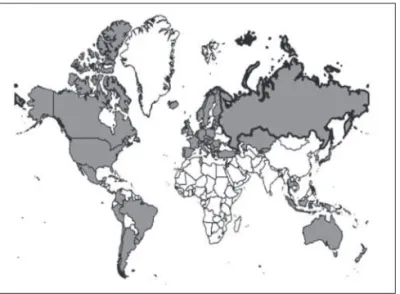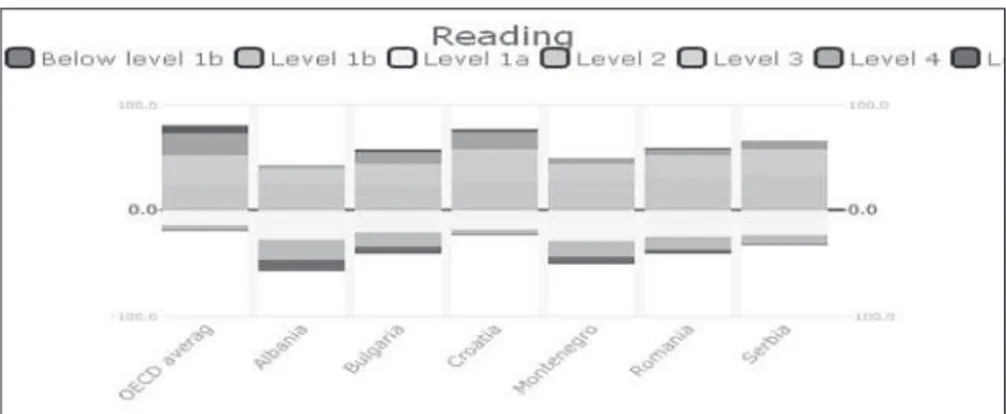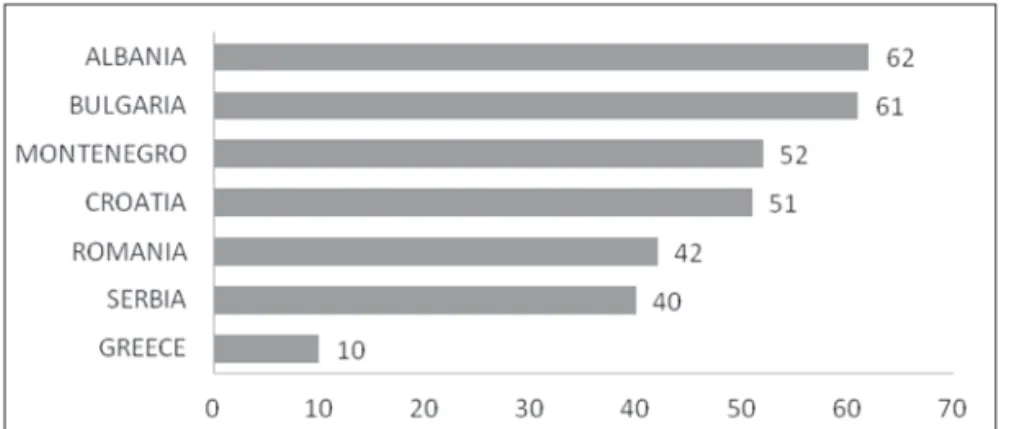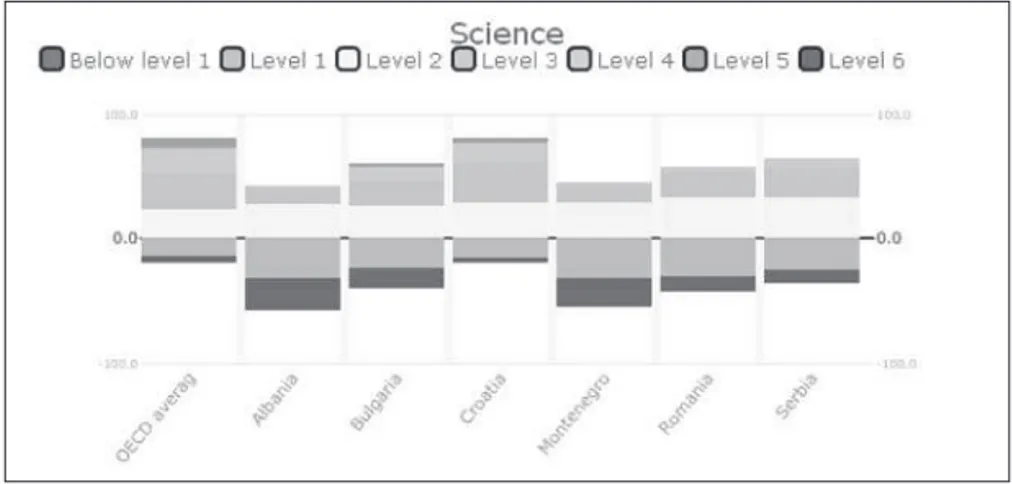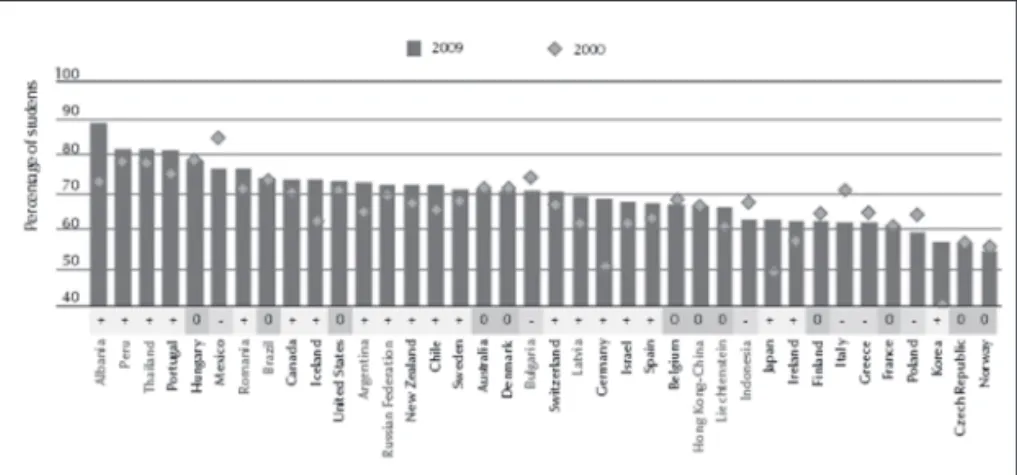A Case Study of Albania’s Participation in PISA 2009
Alfons HArizAj1
• he paper presents a view of the results and progress of Albania in the Programme for International Students’ Assessments 2009 (PISA 2009). he overall goal and objectives of PISA are to ofer support and expertise in the ield of the evaluation of educational development factors in Alba-nia. One of the methods successfully used for monitoring the achieved progress during the given study period was the estimation and compari-son of results with the results of previous PISA participations. A broader comparison of these statistics with those of other PISA participants in the Albanian region provides a real picture of the situation, showing the progress Albania has made and indicating how efective Albania’s edu-cational policies are.
Keywords: Gender diferences, Learning outcomes, Main domain in PISA, PISA assessments, Student performance, he socioeconomic environment,
Introduction
Since 1990, changes and reforms have been implemented in the Alba-nian education system. One important reform was a new evaluation system for primary school and high school through national exams. Such exams are standardised and are performed all over the country at the end of primary and high school education. As the most important international assessment insti-tution, PISA assessment participation makes a contribution to, and is part of, Albanian system reforms.
At the end of primary education (nine-year education), all Albanian students sit two exams in Albanian language and mathematics. he compar-ison of these two inal course results with students’ results in PISA interna-tional assessment has been useful and important in interpreting and analysing
1 National Agency of Exams
achievements, and even more so in evaluating the efect of changes undertaken in students’ education at primary school level.
Albania has participated in PISA 2000 and PISA 2009, and will again be one of the participants in PISA 2012.
Participating countries and Albanian participation in
PISA 2009
Figure 1: Map of countries participating in PISA 2009.
Countries participating in PISA 2009 - OECD (Organisation for Eco-nomic Co-operation and Development) countries are:
1. Australia 2. Austria 3. Belgium 4. Canada 5. Chile
6. Czech Republic 7. Denmark 8. Estonia 9. Finland 10. France 11. Germany 12. Greece
13. Hungary 14. Iceland 15. Ireland 16. Israel 17. Italy 18. Japan 19. Korea 20. Luxembourg 21. Mexico 22. Netherlands 23. New Zealand 24. Norway
25. Poland 26. Portugal 27. Slovak Republic 28. Slovenia 29. Spain 30. Sweden 31. Switzerland 32. Turkey
Countries participating in PISA 2009 - partner countries/economies are: 1. Albania 2. Argentina 3. Azerbaijan 4. Brazil 5. Bulgaria 6. Chinese Taipei 7. Colombia 8. Croatia
9. Dubai (UAE)
10. Hong Kong – China 11. Indonesia 12. Jordan 13. Kazakhstan 14. Kyrgyzstan 15. Latvia 16. Liechtenstein 17. Lithuania 18. Macao – China 19. Montenegro 20. Panama 21. Peru
22. Qatar 23. Romania
24. Russian Federation 25. Serbia
26. Shanghai – China 27. Singapore 28. hailand 29. Trinidad and
Tobago 30. Tunisia 31. Uruguay
Albanian target students in PISA 2000 and PISA 2009
he irst students to take part in PISA 2009 began their irst school year in 2000, which was the irst year that Albania participated in PISA internation-al assessment. Consequently, a comparison of the results of this period provides important input for further analysis of the impact of reforms and changes in the Albanian education system and the country’s educational policies.
Most of the 15-year-old students taking part in PISA 2000 were in the irst year of high school.
In 2009, the 15-year-old students who were the target population of PISA assessment were divided into two approximately equal groups; the irst half were in the 9th grade, which is the last year of primary education, and the
second half belonged to the irst year of high school. his change occurred be-cause of a change in the system that increased primary education from 8 to 9 school years, and reduced high school education from 4 to 3 school years.
Relevant Statistics in PISA 2009 - Albania
Number of 15-year-old students in 2009
Number of 15-year-old students in the 7th grade and higher
Number of students participating in PISA
55,587 students
42,767 students
4,596 students
Albanian students’ performance in PISA 2009
General view of the results of PISA 2000 and PISA 2009
Below we present the results of Albanian students in PISA 2000 and PISA 2009 in three domains: reading, mathematics and science.
Table 1: Albania results in PISA 2000 and PISA 2009.
PISA Albania PISA 2000 PISA 2009
Reading 349 385
Mathematics 381 377
Science 374 391
In Figure 2, we provide a graphic presentation of the change in Albanian performance in two PISA assessments in reading, mathematics and science. We can see from the graph that the result of PISA 2009 in reading represents a great improvement (36 points) compared to PISA 2000. he reading component was the main domain in both PISA 2009 and PISA 2000. Only one subject is the main domain in every PISA, which means that each subject is the main domain every nine years, or ater three PISA assessments. Albania also achieved signii-cant improvement in science (29 points), but the result was not as encouraging in mathematics, which decreased by 4 points.
Figure 2:Comparison of Albanian results in PISA 2000 and PISA 2009.
statistically above the OECD average. his change represents a 35 point increase in boys’ performance and a 39 point increase in girls’ performance. Albania was ranked 60th amongst the 65 participating countries in reading, and achieved 59th
place in mathematics and science.
Albanian students’ performance by subjects - PISA 2009
Albania performance in reading in PISA 2009
Students’ performance by levels in reading
“Since both PISA 2000 and PISA 2009 focused on reading, it is possible to track how student performance in reading changed over that period. Among the 26 OECD countries with comparable results in both assessments, Chile, Israel, Poland, Portugal, Korea, Hungary and Germany as well as the partner countries Peru, Albania, Indonesia, Latvia, Liechtenstein and Brazil all im-proved their reading performance between 2000 and 2009, while performance declined in Ireland, Sweden, the Czech Republic and Australia” (OECD, 2010e).
Table 2:Albanian students’ achievements according to levels.
Level of Proiciency Below level 1b
Level 1b
Level 1a
Level 2
Level 3
Level 4
Level 5
Level 6
Albania 11.3% 18.7% 26.6 % 25.6% 14.4% 3.1% 0.2% ≈ 0%
Boys 17.5% 24.4% 27.2% 19.7% 9.7% 1.5% ≈0% ≈ 0%
Girls 4.9% 12.8% 26.0% 31.9% 19.4% 4.8% 0.3% ≈ 0%
From Table 2, it is obvious that the achievements of 11.3% of the students are below Level 1b, while 43% are in either Level 2, Level 3 or Level 4. At the same time, approximately 52% of the students achieved Level 1a and Level 2, while only approximately 18% achieved either Level 3, Level 4 or Level 5.
Figure 3: Levels of proiciency in reading in countries in the Albanian region.
Gender diferences
PISA 2009 showed an increase in the disparity between females and males in reading literacy, coupled with a general decline in reading engage-ment. Female students outperformed males in all participating countries, al-though the size of the diference varied across countries, with the smallest gap found in Colombia and the largest in Albania.
Figure 4: Gender diferences (girls-boys) in reading in countries in the Albanian region.
Girls performed better than boys in reading in all of the countries in the Albanian region. As can be seen in Figure 4, the results may be classiied into 4 groups:
• Group I – Albania, Bulgaria (62 points, 61 points) • Group II – Montenegro, Croatia (52 points, 51 points)
• Group III – Romania, Serbia (42 points, 40 points)
• Group IV – Greece (10 points)
his diference is more evident, and more or less the same, between Al-bania and Bulgaria, while groups 2 and 3 decreased progressively by 10 points each. Only Greece does not follow the trend of other countries in the Albanian region, with a diference of 10 points.
From this analysis we can conclude that strategies for improvement in boys’ abilities in reading should be the focus of education systems in the coun-tries of the Albanian region.
Changes in student performance since 2000
Based on the results achieved, Albanian students show good or weak achievements in the following aspects:
• Good achievements in reading
– Finding a piece of information in a simple text; – Comparing information;
– Combining diferent pieces of information within a text;
– Identifying the main idea, or the purpose of the author, in a text that treats a known case;
– Finding the meaning of a phrase or single word;
– Creating a simple relationship between the information given in a text and general knowledge of daily life;
– Explaining the type of the text based on the students’ personal expe-riences and attitudes.
• Serious weaknesses in reading
– Confrontation with types of texts unfamiliar to the students; – Integrating information obtained from diferent texts; – Identifying ideas previously unknown;
– Generating abstract categories for developing diferent
interpretations;
– Critical evaluation of a complex text about an unknown case; – Applying sophisticated comprehension beyond the text;
– Critical evaluation of diferent texts and forming a hypothesis on them, thus developing specialised knowledge and processing con-cepts that can be contrary to what is expected.
• Improvements in reading performance were achieved at all proiciency levels
“Chile and the partner countries Indonesia, Albania and Peru showed improvements in reading performance among students at all proiciency levels. … hese countries are also among those that show the largest improvement in mean performance and in which the percentage of students performing below Level 2 decreased” (OECD, 2010e). he lowest achieving students show similar levels of improvement to the highest achieving students in Albania.
• Enjoyment of reading increased
“In a large number of countries, the decrease in enjoyment of reading was much more pronounced among boys than among girls, leading to a widen-ing of the gender gap. Poland and the partner country Albania saw the largest increase in the gender gap in enjoyment of reading. In Albania, girls’ enjoyment of reading increased between 2000 and 2009, but on average in 2009, boys en-joyed reading as much as they did in 2000.’’
• he share of girls reading for enjoyment increased
in some countries in the Albanian region, exceeding 80% in Greece, Bulgaria and Albania.
• Improvement is possible regardless of a country’s cultural context or its starting position
“Among the 26 OECD countries with comparable results in both as-sessments, Chile, Germany, Hungary, Israel, Korea, Poland, Portugal, and the partner countries Albania, Brazil, Indonesia, Latvia, Liechtenstein and Peru all show overall improvements in reading performance. he fact that such a di-verse group of countries succeeded in raising the level of their students’ perfor-mance in reading indicates that improvement is possible regardless of a coun-try’s cultural context or where it starts out from” (OECD, 2011a).
Reading performance by school location in Albania
Students in city schools in Albania perform much better than students in rural schools.
On average across the OECD, students in city schools outperform students in rural schools by 40 score points, or the equivalent of one year of education.
Table 3:Reading performance by school location.
Reading performance by school location Students attending schools
located in a vil-lage, hamlet or rural area (fewer than 3,000 inhabitants) Students attending schools located in a small town (from 3,000 to approx. 15,000 inhabitants)
Students attending schools located in a town
(from 15,000 to approx. 100,000 inhabit-ants)
Students attending schools located in a city
(from 100,000 to approx. 1,000,000 inhabit-ants)
Percentage of
students 25% 20% 27.7% 27.3%
Average performance in reading
347 368 394 426
he results show a progressive increase in the case of schools in a loca-tion with a greater number of inhabitants. It seems that in urban areas with a greater number of inhabitants there is more possibility of guaranteeing a better education system.
the performance gap between students in city schools and those in ru-ral schools is more than 45 score points, ater accounting for students’ socio-economic background. his gap is 80 score points or more – or the equivalent of two years of schooling – in Hungary and in the part-ner countries Bulgaria, Kyrgyzstan and Panama.’’ (OECD, 2010b, p. 14).
Albanian performance in mathematics in PISA 2009
Mathematics performance by levels
he percentage of students with low achievements is too high, with 40.5% of students falling below Level 1, while 30% of students are in Level 2, Level 3 or Level 4. here are more boys than girls below Level 1 and more girls than boys in Level 1 or Level 2, while the same percentage of boys and girls are in Level 3 or Level 4. here are more boys than girls in Level 5
Table 4: Albanian students’ performance by levels in mathematics.
Level of Proiciency
Below
Level 1 Level 1 Level 2 Level 3 Level 4 Level 5 Level 6
Albania 40.5% 27.2% 20.2% 9.1% 2.6% 0.4% ≈ 0%
Boys 43.5% 25.5% 18.8% 9% 2.6% 0.5% ≈ 0%
Girls 37.3% 29% 21.6% 9.1% 2.7% 0.3% ≈ 0%
Levels of proiciency in countries in the Albanian region
Figure 5:Levels of proiciency in mathematics in countries in the Albanian region.
Gender diferences in mathematics performance in countries in the
Albanian region
In Albania, girls outperformed boys by 11 score points. In fact, Albania and Bulgaria are the only countries in the region in which girls outperform boys in mathematics. On average across OECD countries, boys outperform girls by 12 score points.
Albanian performance in science in PISA 2009
Science performance by levels
Assessment in science includes assessment in a group of school sub-jects such as chemistry, biology, physics, geography, and Earth science. Albania achieved 391 points from a possible 575 points.
Table 5:Albanian students’ performance by levels in science in PISA 2009.
Level of Proiciency
Below
Level 1 Level 1 Level 2 Level 3 Level 4 Level 5 Level 6
Albania 26.3% 31% 27.7% 12.9% 2.0% 0.1% ≈0%
Boys 32% 32% 24% 10.3% 1.6% 0.1% ≈0%
Girls 20.3% 30% 31.5% 15.7% 2.5% 0.1% ≈0%
26.3% of students are below Level 1, while 43% of students are in Level 2, Level 3 or Level 4, with the percentage of girls in these levels being about 50% and the percentage of boys being 36%. here is a much higher percentage of boys than girls below Level 1.
Levels of proiciency in some countries in the Albanian region
In Romania, Serbia, Montenegro and Albania, the percentage of stu-dents who reach Level 6 is almost 0%.
Across OECD countries, 8.5% of students are proicient at Levels 5 or 6. he countries with 0.5% or less of students at these levels are Albania (0.1%), Montenegro (0.2%) and Romania (0.4%).
Across OECD countries, an average of 29.1% of students are proicient at Level 4 or higher.
In contrast, less than 5% of students reach Level 4, 5 or 6 in Albania (2.1%), Montenegro (3.4%), and Romania (4.8%). Croatia has the lowest per-centage of students below Level 1, while Albania and Montenegro have the greatest percentage of students below Level 1.
Girls perform better than boys in science in some countries in the
Albanian region
In Albania, girls perform better than boys in all three subjects of PISA assessment. In science, this diference is 29 points more than boys, with boys gaining approximately 377 points and girls 406 points. In Figure 8, we show this indicator for the countries of the Albanian region. Girls outperform boys in all of the countries of the Albanian region. he highest diference is in Albania and the lowest is in Serbia. Greece, Romania and Croatia have statistically the same diference.
Diiculties faced by Albanian students in science:
• In questions in the science part of PISA 2009 assessment, there was a combination of knowledge from diferent subjects. his made it diicult for Albanian students to give exact answers, as the Albanian curricula did not treat exercises of this question type. Some of this knowledge has become part of curricula since PISA 2009 was developed.
• Albanian students had diiculties in evaluating and reaching conclusions in non-standard situations. It seems that describing and reproducing knowledge dominates reasoning, interpreting and arguing. Teacher training is therefore needed in order to provide students with combined knowledge not only in one subject, but in a group of subjects. However, this lack of knowledge does not occur only due to a lack of teacher qualiication, but oten also due to a lack of didactic and experimental equipment, as well as a lack of contemporary information and examples from daily life in Albanian school curricular classes or in Albanian extracurricular classes.
• It is diicult for Albanian students to solve problems from their textbooks. his is partly due to the reasons mentioned above, but also due to insuicient use of other information sources typically ofered by new technology, such as the Internet and scientiic publications aimed at this age group.
Performance in reading, mathematics and science by type of school
According to data analysis on the three domains of assessment, private schools achieved higher results. he best result was achieved in reading, with the diference in mean score of 65 points being more than one school year in OECD countries, as shown in Table 6.
Some of the factors that afect the higher performance results of private schools are:
• As a consequence of the socioeconomic problems that Albania faced during the transition period, public education encountered a lot of diiculties, thus giving private education an advantage as an alternative. • Private schools are located in the country’s main cities.
• he number of students per class in private schools is lower than in public schools.
Table 6:Performance of students in the three domains by type of school.
State schools vs. independent private schools1
Percentage of students
Performance in reading (mean score)
Performance in mathematics
(mean score)
Performance in science (mean score)
Diference in the perfor-mance on the reading scale between public and
private schools. Difer-ence (Public – Private)
11.1 442 426 445 -65
Other aspects of Albanian results in PISA 2009
Teacher-student relations in PISA 2000 and 2009
he following graph shows the percentages of students agreeing or strongly agreeing that “Most of my teachers really listen to what I have to say”.
It is evident that in Albania, more than in other countries, students re-port their teachers’ willingness to listen to them and to help them.
Figure 9:he percentage of students agreeing/strongly agreeing that “Most of my teachers really listen to what I have to say.”
students’ reading engagement are observed in Kazakhstan, the Russian Federa-tion, Kyrgyzstan, Azerbaijan, Montenegro and Albania” (OECD, 2010d).
Classroom discipline in PISA 2000 and 2009
his indicator improved from 2000 to 2009 in many countries partici-pating in PISA evaluation.
“Students who reported that there are few disciplinary problems in their classes perform better in PISA than those who reported that a lack of discipline in class disrupts learning.
• Between 2000 and 2009 classroom discipline improved in many coun-tries that participate in PISA, and the majority of students in OECD countries enjoy orderly lessons.
• Generally, countries where discipline in the classroom improved betwe-en 2000 and 2009 are also those where studbetwe-ents reported better relations with their teachers.
PISA ofers no evidence to support the notion that discipline in school is a growing problem and that students are becoming progressively more dis-engaged from school. In fact, between 2000 and 2009 discipline in school and teacher-student relations improved” (OECD, 2011b).
he impact of the socioeconomic environment
he impact of the socioeconomic environment on assessment results was lower in 2009 than in 2000. hus we can conclude that Albania still has potential resources for improving the achievements of Albanian students that are not related to socioeconomic resources.
PISA 2009 results show that the impact of a student’s socioeconomic background on his or her performance has weakened signiicantly in Albania.
“Among countries that showed improvements in reading performance, changes in the demographic and socioeconomic composition of student popu-lations had the largest impact in Israel and the partner country Albania, where the improvement in student performance would have been seven and 12 score points larger, respectively, if the demographic and socioeconomic context had been similar in 2000 and 2009” (OECD, 2010a).
Performance of students with an immigrant background in the host country by country of origin
Albanian students in host countries had lower achievments than stu-dents of the host country. Albanian stustu-dents in Montenegro had the lowest achivements and those in Greece had the highest achivements in relation to the achivement of the host country.
Table 7:Albanian students’ performance in host countries.
Albanian students in host countries Switzerland Greece Montenegro
Mean of the country 501 483 401
Students from Albania 384 439 373
Figure 10: Graph of Albanian student performance in host countries.
Pre-primary school attendance improves student performance
Table 8:Performance according to pre-primary school attendance.
Performance by pre-primary school attendance
No pre-primary school attendance
Pre-primary school attendance for one
year or less
Pre-primary school attendance for more
than one year
Percentage of students 24.5 22.7 52.7
Average performance in
reading 371 385 404
• 15-year-old students who have attended pre-primary education perform better in PISA than those who have not, even ater accounting for their socioeconomic backgrounds.
• Disadvantaged students have less access to pre-primary education than advantaged students in almost every country, particularly those in which pre-primary education is not widespread.
• High-performing and equitable school systems are also those with little socioeconomic disparity in access to pre-primary education.
• How pre-primary education is provided afects the extent to which attendance beneits individual students.
Widening access to pre-primary education can improve both overall performance and equity by reducing socioeconomic disparities among stu-dents, if extending coverage does not compromise quality.
he most important factors in PISA 2009 results
Socioeconomic variations
During the years 1990-1999, the overall socioeconomic development in Albania underwent huge changes. he efect of this was evident even in the results that students achieved in PISA 2000. Over the subsequent ten years, Al-bania achieved encouraging socioeconomic growth and stability. he positive efects of this were again seen in students’ results in PISA 2009. Consequently, we can see that in Albania socioeconomic development is the most important factor in the level of educational results. his argument becomes even more convincing if we examine the progress in reading results, which were not only higher but were almost in same level for both boys and girls.
students’ results are higher in schools located in urban areas.
Education system reforms
Since 1990, many changes have taken place in the Albanian education system, especially in the pre-university system. In order to improve the quality of education for preschool children making the transition from kindergarten to elementary school, new educational programmes and methods have recently been introduced. he curricula of the elementary education system were the irst afected by the changes, mainly in terms of textbooks and educational pro-grammes. hese programmes aim to use interactive teaching methodology in elementary school. Teachers in the Albanian education system have attended continuous training modules on these programmes for several years and are now implementing them successfully.
Changes and improvements have occurred in the main ields of educa-tions in the form of: managing and inancial administration, curricular pro-grammes, school textbooks, the external and internal evaluation system, new didactic technologies, etc.
Recommendations on educational policy by subjects
Reading
he actual curricula in reading seem to be more suitable for students with high results. he plan for overall comprehensive curricula is really essen-tial. Certain parts of the curricula should be relieved from overburdening; these are key parts of the curricula that transmit numerous concepts at the same time, making the intelligibility of these concepts more diicult for students. he reading part of the programme is mainly taken up by iction, and little scope remains for other kinds of literature or for so-called informative, descriptive literature, etc. However, it is a well known fact that iction is oten regarded by students as diicult, irstly due to the nature of the topics and secondly because in some cases it is not selected in accordance with students’ age. Furthermore, there is not enough space for other kinds of literature that are nowadays oten encountered by the students themselves, such as reading informative texts, re-ports, advertisements, etc.
Mathematics
improvement of curricula is more essential than other factors that might have afected in this result.
Programmes and textbooks should be improved, as there are some as-pects of mathematics that are not included as much as necessary. Geometry and graphical presentations should be more comprehensive and integrated into the subject programme of mathematics. Educational textbooks and programmes should allow new and diicult concepts to be treated longer in class.
he transition of the existing 9th grade of primary education to high
school is not properly relected in the respective programmes and textbooks. In order to guarantee the required progress, this transition should be associ-ated with the necessary scientiic and didactic qualiications of mathematics teachers.
he result of students with the lowest achievements must be improved, as the percentage of such students is unacceptably high, with 40.5% of students achieving results below Level 1 (Table 4).
he results of national exams at the end of the 9th grade must be analysed
more deeply and compared with the results obtained from PISA assessments. In the national exam of mathematics at the end of 9th grade, 75% of students gained less than half of the maximum points.
Data provided by national assessments must be examined further in or-der for important conclusions to be reached, thus making the comparison of these results with those of international assessments more efective.
Science
In the curriculum of the nine-year school system, knowledge for a group of subjects, such as chemistry, biology, physics, geography, etc., should be inte-grated. Furthermore, the basic required logistics should be organised, such as equipment and labs that in most cases are mandatory for this subject, and the use of new information technology should be encouraged.
Not all students have the possibility of obtaining this kind of informa-tion individually. In school environments, such as libraries and Internet rooms (centres of knowledge development), there should be teachers who can support students in expanding their knowledge.
Instead of the traditional lecturing method, teachers should practise new methods putting the students at the lesson focus, thus giving priority to student discussion and ways of thinking and reasoning.
implemented. he qualiication of teachers of grades 6-9 should be the main focus.
“When it comes to learning, it’s the quality of teaching at school and students’ attitudes towards learning that count most, not the number of hours students spend studying”(OECD, 2011c).
Improvement of low student achievements in reading, mathematics and science
In most countries, students who are poor performers are mainly boys from socioeconomically disadvantaged backgrounds. Results from PISA indi-cate that this group is far from being equipped with the skills and competencies needed to participate fully in society.
he achievements of students with low results should be improved due to the fact that the percentage of such students is very high. Furthermore, the factors afecting this result should be identiied. Some of these factors have been mentioned above; however, we should highlight the fact that inding ways to motivate reading, especially in boys, and focusing increased attention on social groups with socioeconomic diiculties, still remain the key factors.
In many countries, progress was made towards achieving greater equal-ity in learning outcomes during the 2000-2009 period.
“Improvements among the lowest performing students do not have to be realised at the expense of the highest performing students… In none of the countries where the lowest performing students improved did the highest per-forming students show a decline in their performance” (OECD, 2011a).
PISA RESULTS SUGGEST HOW COUNTRIES CAN IMPROVE THEIR PERFORMANCE.
References
Evaluation of Students’ Achievements (2007). National Agency of Evaluation of Students’
Achievements (AVA), Albania.
Evaluation of Students’ Achievements (2008). National Agency of Evaluation of Students’
Achievements (AVA), Albania.
Improvement of Teacher Qualiications (2009). Tiranë: Institute of Curricula and Training (IKT).
Ministry of Albanian Education (2011). Conference of Albanian PISA 2009 Results.
Report of State Matura of Albania 2007, 2008, 2009, 2010. National Agency of Evaluation of Students
Achievements (AVA), Albania.
OECD (2010a). PISA 2009 Results: What Students Know and Can Do – Student Performance in
Reading, Mathematic and Science, OECD Publishing, (Volume I). Retreived from http://dx.doi.
org/10.1787/9789264091450-en.
OECD (2010b). PISA 2009 Results: Overcoming Social Background – Equity in Learning
Opportunities and Outcomes (Volume II). OECD Publishing. Retreived form http://dx.doi.
org/10.1787/9789264091504-en.
OECD (2010c). PISA 2009 Results: Learning to Learn (Volume III). OECD Publishing.
OECD (2010d). PISA 2009 Results: What Makes a School Successful (Volume IV). OECD Publishing.
OECD (2010e). PISA 2009 Results: Learning Trends– Changes in Student Performance since 2000
(Volume V). OECD Publishing.
OECD (2011a). All countries can improve their students’ reading performance. PISA in Focus, (2,
March).
OECD (2011b). Has discipline in school deteriorated? PISA in Focus, (4, May).
OECD (2011c). Does investing in ater-school classes pay of?. PISA IN Focus, (3, April).
he Student Evaluation Standards (2003). California, USA: Corwin Press, Inc..
